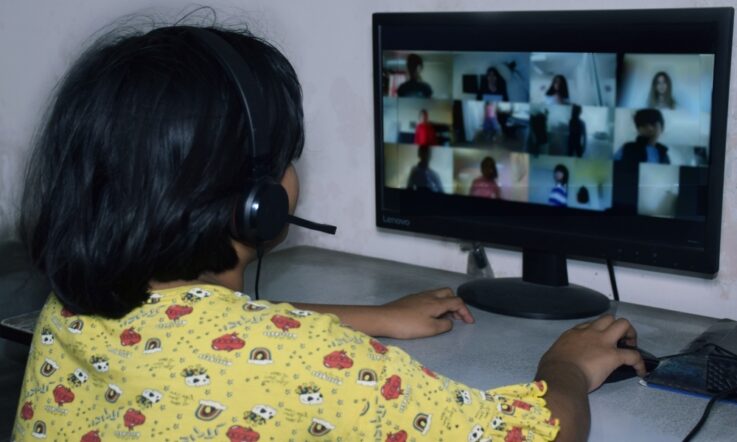Events of the last two years have forced teachers and principals to think differently about how they can continue to best meet the needs of students and their families in times of change and uncertainty. In the first article of our series on ‘Learning during the pandemic’, educator Geeta Gujral shared how her school has provided opportunities for students to share their experiences and emotions. In our latest contribution, Head of DLF World School and science educator Dimple Puri discusses flexible assessments for online teaching, with examples from her own classroom.
The global lockdown of education institutions caused major (and likely unequal) interruption to students’ learning. How could I mitigate these negative impacts in my own school context with regards to assessment?
Due to the pandemic restrictions, many schools and institutions strived to create a student-centred, flexible, remote learning environment. This called for more student ownership and flexibility not only in the ‘input’ but also in the assessment process – from what and when to assess, to the use of feedback, by educators to inform their next steps and by students to reflect upon their learning.
The need for flexible assessment is important within inclusive education, to allow students to have a valued ‘voice and choice’ in the classroom dynamics, to plan and modify their own learning journey to identify what has been learned and what needs to be learned next.
Creating flexible learning spaces in assessment requires, as a starting point, self-knowledge of learning preferences from the part of teachers. This then needs to be checked against your students’ needs. Feedback for learning in both synchronous and asynchronous environments is crucial. However, I believe the ultimate test that a teacher needs to take and pass, day in and day out, is student engagement. In my experience, flexible assessment is not only more supportive, but it also enhances student involvement and engagement levels.
A case study from my classroom
Ideally, flexibility should be offered in terms of tools used, style of assessment, timeline of submission, specific content or topic, type of evaluation and feedback mode. Not all of these aspects may be possible at once, but teachers can start by being flexible in one or two. In my case, I wanted to provide total flexibility.
The aim was to design flexible assessments for middle school students for classes VI-VIII (age 11-14) based on activities allowing every student to choose a format that would enable them to express their ideas. I also wanted to encourage their participation in the learning process and promote self-regulated learning skills.
The traditional assessment format in the Curriculum theme Water Conservation consists of all students of Class VII demonstrating a coherent, well-structured critical argument on the given topic, in writing – this is teacher-driven and based upon a one-size-fits-all approach. My alternative plan of assessing with the help of flexible assessment was designed to give my students a project to be prepared on the theme of Water Conservation. Within the theme, I provided students with a selection of digital resources or options to showcase their learning. The tools provided catered for diverse learner needs and preferences, thereby supporting them to more easily meet the wider intended learning outcomes.
I provided scaffolding and support by providing background knowledge – including through interdisciplinary subjects like mathematic (data analysis) and science (management of wastewater) – clear guidelines, and intended, overall learning outcomes encompassing skills, knowledge and attitude.
The project's biggest thrust was on a case study proposal to be prepared on how to save India's water bodies with a focus on the Sustainable Development Goal number 6: Clean Water and Sanitation, which aims to promote increased investments in water management and sanitation as among the most critical issues faced by humankind.
I gave students a clear outline of the scope and suggested tools like Google Presentation, Flip grid, Adobe Spark and Collage Maker. Students could choose any of the tools to make their project. There was no deadline, but a duration of the activity, and the evaluation criteria involved self- and peer-assessment based upon the rubrics specified for each tool.
I found that this student-led approach helped to identify areas of student interest and allowed them to take the lead in identifying resources to clarify concepts. Unobtrusive, regular monitoring from my part and regular self-evaluation helped students in not only improving academic performance compared to the previous year but also to build self-confidence.
Benefits of flexible assessments
Flexible assessments give students autonomy and choice in their learning while allowing teachers to differentiate, observe, and assess in real-time. This approach increases student ownership and provides teachers with opportunities to differentiate and support students at their individual learning levels. The flexibility means students have the power to choose how to learn a particular subject or concept. It also allows them to work on the activities at their own pace. Such assessments are also useful for teachers, enabling them to identify and hone student interests and preferences to stimulate active learning and engagement. This freedom, in turn, encourages students to be more responsible, accountable, and independent in their learning.
Feedback from students
Feedback from students on this new approach was positive. They remarked that building flexibility into the assessment process enabled them to take ownership of their learning.
Other comments include: ‘My teacher was a facilitator who provided me with an array of tools to showcase my learning on the project Water Conservation. I was offered flexibility in terms of tools used, style of assessment, timeline of submission, type of evaluation and feedback. This kind of student-driven assessment [was inclusive] and made me motivated. I submitted my assignment on time, and it helped me to achieve intended learning outcomes [with] better grades and motivation.’
Final reflections
I believe that a good assessment environment elevates students’ expectations, inspires them to participate, and ensures that no student can fly under the radar.
Bringing in flexibility means the focus remains learner-centred, actively engaging students with the teaching-learning process. My students’ academic performance improved, along with their motivation and self-confidence. The flexible approach also helped them to develop a love and interest in the topic they were studying.
On a practical note, each tool of assessment has specific strengths and limitations, so I would recommend assessing through different activities and tasks to make it as stress-free and stimulating as possible for students.
Furthermore, flexible assessment should not happen in isolation from the other aspects of teaching and learning, it should be part of a wider flexible learning approach. Students, teachers and families are facing enormous pressures that will make re-enrolment challenging as schools reopen. Educational stakeholders are recommended to implement flexible approaches to encourage enrolment and consider additional strategies to support transition back to school.
Keeping this wider ordeal in mind, I will strive to be a flexible teacher, even in an offline mode, as schools successfully reopen post-pandemic. I wish to be a role model, providing learners with an autonomy to choose a best-fit, personalised mode of assessment and tools like storytelling, role-plays, project reports, and Ted Talks (to name a few).
Fostering the social-emotional connect, I will welcome back my students by leveraging a carefully designed and balanced range of alternate flexible assessment tools, coupled with the best suitable technological interventions for developing love before lessons and grace before grades.
How has your school adapted to meet the needs of students and families during the pandemic?
Thinking about your own students, what strategies do you use to engage them in learning and assessment tasks? Has this changed during the pandemic restrictions? What have the benefits and challenges been?



